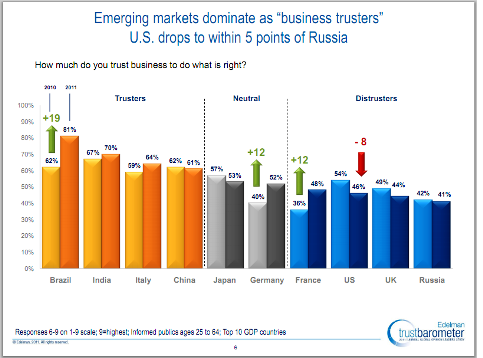Recently the New York Times partnered with Latitude Research to review the psychology of sharing. Based on their in-depth study of 2500 participants they found… 9 reasons why your viewers aren’t sharing your content.
#1: Your customers don’t trust you
Stated plainly, people do not care to share your content if they don’t find you, or your content. to be trustworthy.
The 2011 Edelman Trust Barometer found that globally only 56% of people trust businesses to do what is right. However, in the US, the UK and Japan, that number fell significantly between 2010 and 2011.
#2: Your fans don’t care about your Business
I know that is not good news to hear, but your fans have short memories. They wonder “what have you done for me lately?” In this failed economy more people are looking for business people who listen or offer help towards them meeting their goals.
Your viewers are looking for valuable information, great deals and a chance to meet other people who share their interests. As soon as you stop offering these things, your viewers will go looking elsewhere.
They may not feel a commitment to your business, but you can keep them interested in your content.
#3: Your posts are boring
People are far more likely to share something they find intriguing or funny.
There are hundreds of cases now on file where humor and wit are part of the content. Seeing someone has a sense of humor plays a huge part in build solid relationships with viewers. Do not be afraid of posting humorous style content. The best viewers, fans or friends all should have a smile on their face.
#4: People care about causes more than businesses
The New York Times found people are more likely to share something they are passionate about.
Frankly, people rarely wake up wondering what they can do for a business today. However, they do dream of ways to help their favorite cause. Whether it’s ending poverty, supporting Greenpeace or advancing a local charity, many people give sacrificially to help things they care about. Having a cause you support can also get viewers to share your content.
#5: People share to build relationships with others
Research shows people value relationships with other people, not necessarily with businesses. Viewers are definitely looking for communities. Your business might be able to create a social network for that community as long as Trust building is factored into the process.
Here are two interesting factoids from The New York Times study:
- 78% of respondents use links to stay connected to people they otherwise may not stay in touch with.
- 73% of respondents said sharing content helps them find people with common interests.
People who find your content compelling enough to share with their viewers or friends are showing their communities they Trust you and your content.
#6: Customers are looking for validation
This has to be the biggest point made in this survey. Validation of sources..especially the wild claims made with unbelievable numbers…is what has changed since social networking has started. We are all trying to build credibility in the eyes of our friends. We want to be seen as experts in some area(s).
The way we do this online is through the content we share.
68% of The New York Times study participants said they share content as a form of advertisement for themselves. They want to give others a better sense of who they are and who they trust.
Making sure the content is valid is what many business people today have little care about doing. They seem to enjoy telling people they have sixteen thousand Followers on Twitter but fail to validate the statement with telling viewers how many of them are real people or, better yet, how many read anything posted on Twitter.
The quickest way to break someone’s trust is with attempting to be someone you are not or providing information that can’t be validated.
#7: You’ve misunderstood your audience
Knowing your viewer or your customer is probably one of the most understatement content provides use. Knowing the persona of the person the content is targeted is the only way to compel them into sharing your information with others.
The New York Times study found there are six sharing personas for online fans. Understanding who your customers are can help you identify common motivators:
- Altruists—Altruists share content out of a desire to be helpful and aspire to be seen as a reliable source of information. Preferred tools: Facebook and email.
- Careerists—Careerists are well-educated and seek to gain a reputation for bringing value to their networks. They prefer content that is more serious and professional in tone. Preferred tools: LinkedIn and email.
- Hipsters—Hipsters are younger sharers who have always lived in the “information age.” They use Twitter and Facebook to share cutting-edge and creative content. They share content to build their online identity. Preferred tools: Facebook and Twitter.
- Boomerangs—Boomerangs seek validation and thrive on the reaction of others to their content, even when it’s negative responses. Preferred tools: Facebook, email, Twitter and blogs, wherever people will engage them.
- Connectors—Connectors see content sharing as a means of staying connected to others and making plans. They are more relaxed in their sharing patterns. Preferred tools: Facebook and email.
- Selectives—Selectives are more thoughtful in what they share and with whom they share it. They personalize their sharing and expect responses to their content. Preferred tool: email.
Did you notice how many of these prefer email? This indicates that short 140 character communiqués are not cutting it with most viewers. Gaining a complete understanding of something is what most viewers prefer.
#8: People are more personal with email
The study discovered people have not abandoned email. In fact, participants share most frequently through email and consider it more private. Therefore they have higher expectations for responses through email.
As displeasing as email may be sometimes it still is the primary source of private communications. So pointing viewers to an email sign up, as old school as that seems, does provide those searching for greater value the opportunity to communicate directly. For businesses this is like someone walking in the store and asking ‘how much is that puppy in the window?’.
Social Media Does Rule
Posting content in the Social Spaces is still evolving. As sounder way of communicating are launched, and as more practical ways of searching for information is developed, posting content in the social spaces will become the main source of viewing for people.
One of the most overlooked rules in content creation is the rule of simplicity. Shorter posts (less than 500 word blogs) get shared 27% more frequently. Keep your writing style at a fifth grade or lower level of understanding.
Finally, remember getting your content shared is just the first step. See this as part of longer-term strategy of building a loyal following and…TRUST.
Let me know how I can help.
 Contact Scot Duke for a Complementary 30 minute Business Operations Evaluation Session. When it comes time to check your business’ direction it’s time to talk to someone experienced in business operations. Contact Scot Duke for a Complementary 30 minute Business Operations Evaluation Session. When it comes time to check your business’ direction it’s time to talk to someone experienced in business operations. |












